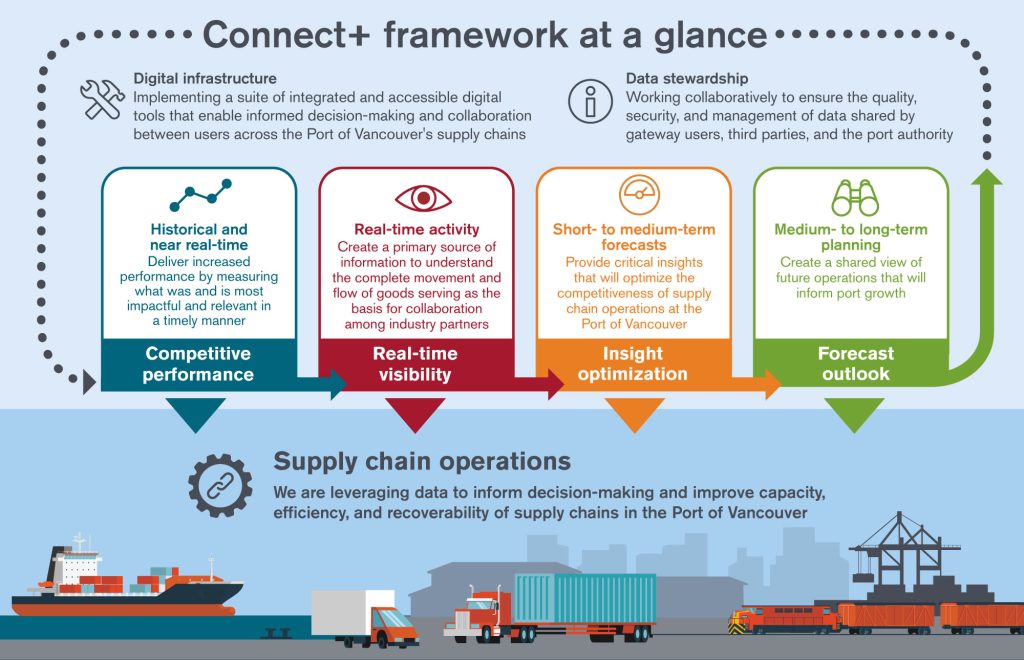To receive project updates and be notified about Connect+ initiatives, sign up for our newsletter. Email: [email protected]
The Vancouver Fraser Port Authority is partnering with industry and stakeholders to advance Connect+, our approach to data stewardship and implementing shared digital infrastructure. The program aims to ensure timely and accurate information is supporting short- and long-term decision-making to improve the Port of Vancouver’s supply chains capacity, efficiency, and ability to recover from disruptions.
Benefits of the program
With a federal mandate to enable Canada’s trade through the Port of Vancouver, the port authority is leading Connect+ initiatives that will:
- Increase capacity and operating efficiencies and reliability across the supply chain
- Reduce operational bottlenecks
- Maximize the performance of existing infrastructure and available network capacity
- Enable information sharing between supply chain stakeholders
- Inform decision-making, individually and collectively for infrastructure investments, policy decisions, and day-to-day operations
- Enhance transportation planning and modeling to support future supply chain infrastructure improvements
- Support the short- and long-term growth of economic activity through the gateway
- Ensure Canada’s supply chains remain competitive
- Reduce the impacts of trade activity on local communities and the environment
Collaboration with industry
The port authority continues to widen and deepen its collaboration with industry partners and stakeholders to expand the range of supply chain data available to develop the analytical tools to build an insight-driven gateway.
This includes working together to develop data governance and security frameworks and data sharing agreements to support Connect+ projects and initiatives.
Connect+ projects and initiatives
There are several Connect+ initiatives underway to optimize goods movement at the Port of Vancouver, and more are planned that will build on program outcomes and successes.
|
Marine transportation |
The Active Vessel Traffic Management (AVTM) Program is a new, multi-part system developed to enhance marine safety, enable the efficient flow of goods to and from the Port of Vancouver, and help manage environmental and social impacts of commercial ship traffic in the region, such as ambient noise and light pollution. The AVTM system is designed to:
Another project on the marine transportation side, the Container Visibility System project, provides real-time visibility into container movements through the Port of Vancouver. Cameras and computer visioning equipment will be used to capture data by identifying containers and merging this information with key modal data elements. This new visibility tool will support improved operational decision-making by providing advanced notification to terminal operators of incoming containers, allowing them to adjust equipment and labour. This technology will also enable reporting of key performance indicators that can be shared as a basis for discussions with industry partners around operational improvements. |
|
Rail transportation |
The Supply Chain Visibility Program is a near real-time digital dashboard that monitors supply chain performance across all commodities and allows users from railways, major shippers, and terminals to improve fluidity and planning by identifying operational constraints and capacity bottlenecks. The centralized and visualized data is:
This project is being developed by the port authority in collaboration with Transport Canada, the Prince Rupert Port Authority, and other Pacific Gateway partners with funding received in 2019 from Transport Canada’s National Trade Corridors Fund. |
|
Road transportation |
Over the last decade, we have continued to build on drayage truck reporting programs that help provide insight into the movement of containers at the port. Through the port authority’s Truck Licensing System, all container trucks that are registered and approved to serve the port’s marine container terminals are equipped with Global Positioning System (GPS) units. The GPS data is used to calculate average terminal turn times and supports the Wait Time System that pays out the Gate Efficiency Fee to eligible trucking companies and independent operators on behalf of container terminals. Insight from GPS data showed that the Port of Vancouver has some of the best turn times in North America since 2014. |
For more information
For program updates, please subscribe to our Connect+ email list.
Email: [email protected]
Newsletters and updates


